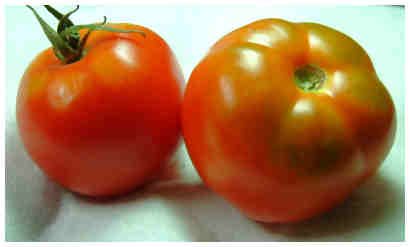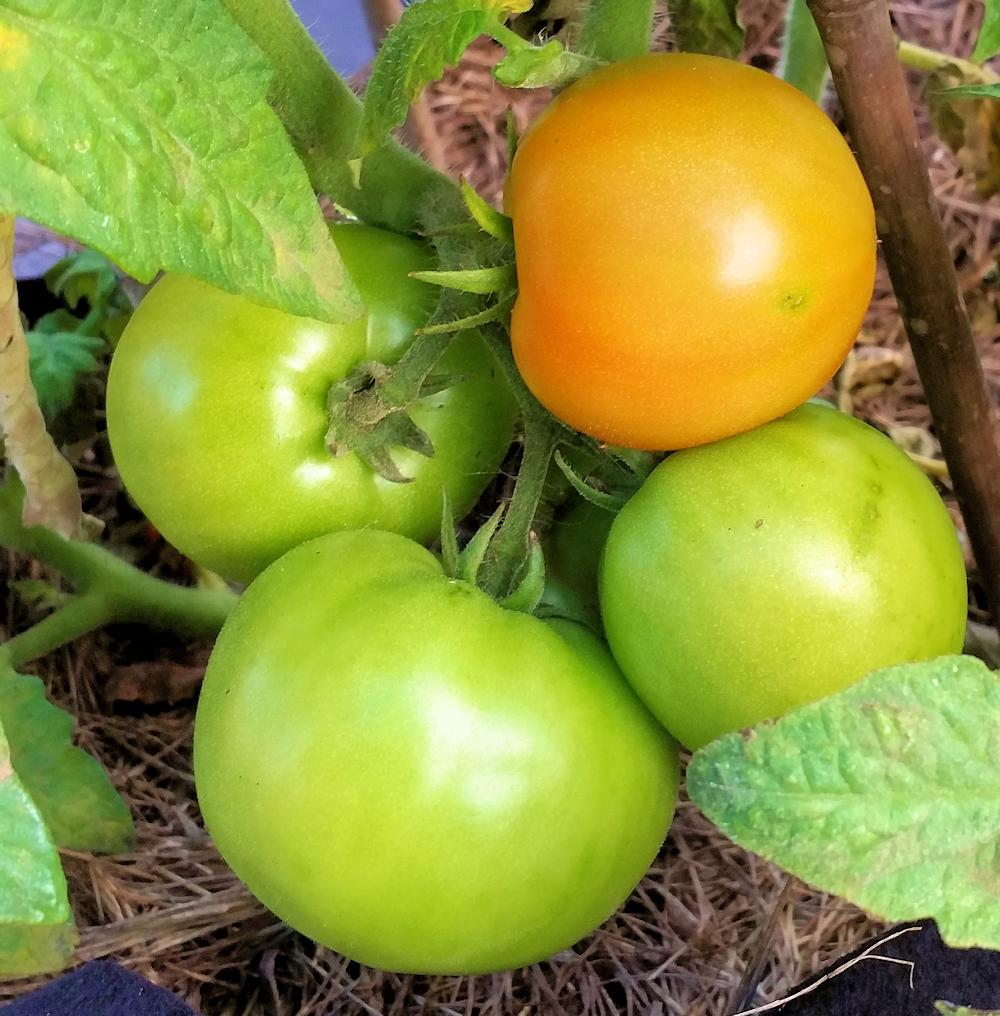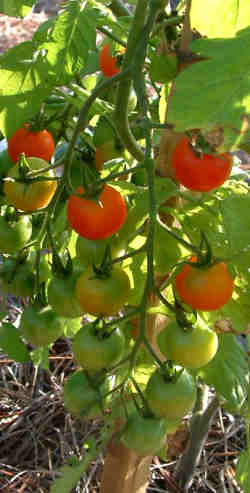growing hybrid tomatoes
Tomato Garden Update – April 2016
It’s just past the middle of April, and so it’s time for garden updates — and this time, I have a video showing the plants and the tomatoes! So it’s not just photos, but lights! camera! action! 😉
But first, I said I’d talk about Juliet, Cherokee Purple and Husky Cherry Red (since I didn’t cover them in my last update).
The Good and the Bad
Let’s start off with the bad and work on up to the good. Cherokee Purple…may you rest in peace! I’m afraid the salt damage that most of the other plants kind of shrugged off was Cherokee Purple’s death warrant. Alas, it’s not a variety that can handle excessive sodium well. I had to just pull it out, and put it out of its misery.
Juliet is next on the list; the plant is not doing great (as you will see in the video), but it’s certainly not at death’s door. And unfortunately (kind of), it’s still setting tomatoes. You’ll hear why I say that in the video.
Husky Cherry Red is doing fine, aside from being targeted by birds! Apparently they love the sweet cherry tomatoes that the plant produces, so I had to wrap the plant up in insect netting. But at least now I get to eat the tomatoes instead of the birds beating me to them!
As for all the other plants — I’ve had ripe tomatoes to eat this past week — yum! Not all the plants have had fruits ripen as yet, but it’s mostly the big beefsteak tomatoes that are hold-outs. Then again, they are growing some really good sized fruit, so they can be somewhat excused. 😉
Video Walk-Through
So, here’s a video walk-through of the tomatoes. Keep in mind some of the salt damage that I have had. We’ve also had some days over 90 degrees Fahrenheit already, and then weather that is somewhat cooler than normal. I don’t think the tomato plants quite know what to do!
Anyway, hope you enjoy the walk-through. Meanwhile, my second wave of seedlings (Rapunzel, Indigo Cherry Drops and Loxahatchee) is almost ready to get potted up for the last time before heading out to the garden for their final planting. More on them later!
Hybrid Tomatoes, a Few Weeks Later
It’s my first report on my hybrid tomatoes (see the original post here at hybrid tomato experiment). So how are all the plants doing? Well, there’s good news and bad news — here’s what’s happening.
I planted 8 F2 seeds, and all sprouted — good news so far, especially since they looked pretty good. Too bad it didn’t stay that way! (On the other hand, that’s the reason for experiments — you never know what will happen.)
Of my original 8 seedlings, four have survived. OK, 6 survived, but two of them were growing only so-so. Since I want plants that thrive, I pulled ‘em up and tossed them. Yes, it seems harsh, but I don’t need plants that don’t do well for me.
Hybrid Tomatoes That Survived
Of the four plants that have grown well, two are determinates, one is indeterminate and the other seems almost between the two — like a stocky indeterminate.
One of the determinates, plus the one that’s a definite indeterminate, have flowers — a good sign! So these two are in the running for keeping seeds from the tomatoes they produce. But does that mean that the other two don’t have a chance (except for eating what they produce)?
No, part of this experiment is on how they grow and how soon they produce, but the other part is the actual fruit — how large the tomatoes and even more important — how they taste. There’s really no reason to grow tomatoes that are bland or mushy in texture. So earliness is only part of the reason to grow a variety.
I also live in a very hot and humid place — it’s only April, but it’s been over 90 degrees several times already this season. So any plant that can grow and produce fruit in my location gets an automatic vote for keeping seeds from it.
Stay tuned!
Hybrid Tomato Experiment
This year in my tomato garden instead of growing heirloom tomatoes, I am growing all hybrid tomatoes. So why the change? It’s because I’m doing hybrid tomato experiment. Let’s see what’s going on.
A Review of Hybrid Tomatoes
So what is a hybrid? A hybrid is a plant that has two different parents. For example one parent can be a red tomato and the other parent can be one colored yellow. In my particular case I have a tomato plants that had two very different parents. One parent was a white tomato, and the other parent was a red tomato.
How do I know this? It’s because I have a packet of seeds for a white determinate tomato, and from that packet I got a plant that was an indeterminate red tomato. This means that my red tomato was a hybrid. An accidental hybrid probably, but it’s a hybrid nonetheless.
The F1 Generation
That red tomato that grew from a packet of white tomato seeds, was an F1 hybrid. But what is an F1 hybrid? It’s the first generation from a cross between two different parent plants.
Since I grew out more seeds from that particular packet and I got white determinate tomatoes, I suspected that my red tomato was F1 hybrid. However, I would not know that until I planted seeds from those red tomatoes. (The photo is of two of the fruits off the F1 plant.)
This year I planted eight seeds from the red tomato plant. And what did I get? I’ve got both indeterminate and determinate plants. This means that my red tomato was indeed an F1 hybrid cross.
The F2 Generation
My eight little plants growing this year are the F2 generation. These are the progeny of my F1 plant. What can I expect to get? Determinate and indeterminate certainly, but what about tomato size and color? That’s where things get interesting.
When it comes to tomato genetics, the color red is dominant over any other color. This means that I will undoubtedly get red tomatoes, can I expect any other color?
It’s hard to say. I might get some white determinate tomatoes, but with only eight seeds planted the chances are slim. That isn’t to say that I won’t get lucky!
My F1 plant had red tomatoes that were been 3 and 5 ounces each in size. However the white determinate tomatoes that I planted, had fruit that were about 7 ounces each. My hope is that I can get some nice red tomatoes in the 6 ounce size range.
As for the determinate plants that I have growing, I expect they will be red. However, you never know what kind of colors might show up; after all, this is a hybrid! And I have no idea what that red tomato was crossed with. The only thing I know for sure is that it was a determinant.
So stay with me, and we’ll see what these plants turn out to be. But I’ll keep you posted through the growing season. It certainly will be an interesting hybrid experiment!
Hybrid Tomatoes
Hybrid tomatoes sometimes get a bad rap. While I will agree that most heirloom tomatoes have a better overall taste, let’s face it – any homegrown tomato will taste better than one from the grocery store!
So why are hybrid tomatoes looked down upon at times? Are they truly worth growing? And what makes a hybrid different from an open-pollinated tomato?
What Are Hybrid Tomatoes?
As you probably know, a hybrid is a cross. The hybrid tomatoes are simply crosses between two different varieties to create a third.
So why make these crosses? Here’s one reason — a particular tomato variety may have superior disease resistance, but the tomatoes produced aren’t very tasty. Since disease resistance can be crucial for some growers, a cross is made to a tomato with great taste. The resulting cross will include better disease resistance combined with better tasting tomatoes.
Another reason for a cross might be to create a tomato specifically for a very warm or very cool climate.
Here’s something important to note; if you plan to save seeds from your crop, don’t bother with a hybrid. This is because the seeds can resemble the “grandparents” more than the parent plant — in other words, they might be great or they might be tasteless. The magic only happens when the two varieties are combined.
(On the other hand, an open-pollinated tomato is a stable cross over many generations and reproduces itself.)
Hybrids and Taste
I’ll be the first to admit that most hybrids aren’t as sweet as most heirlooms. But if all you’ve ever had are the plastic-tasting tomatoes from the grocery store, a homegrown hybrid tomato will taste like heaven! Still, the hybrid cherry tomato Sungold is just about unbeaten for sweetness — by either hybrid or heirloom! And you can see my Supersweet 100 plant in the photo above — those were tasty cherry tomatoes. 😀
A lot of hybrids are bred for disease resistance or for being early or something like that. Not many hybrids are bred for taste alone, but they are out there! I have the tomato Glory on my list of tomatoes to try this summer, when I grow most of my hybrids.
Why Grow Hybrids?
I live in South Florida, and our summers are brutal here — strong sunlight, very hot and very humid. The combination isn’t great for setting tomato fruits, but is just right for bacterial and fungal diseases. When I grow tomatoes in the summer here, I need the extra properties of the hybrids to keep me in tomatoes!
But if you live in a cool, short-summer climate, you’ll likely be wanting a hybrid that is bred for a cooler climate. An early-season tomato variety bred for cooler weather, like Early Girl. Most heirlooms are later-season plants, and won’t grow fast enough in a short-summer climate.
A good percentage of determinate tomatoes are hybrids, and if you want most of your tomatoes ripe at the same time (like for preserving), then determinates are what you need.
If you plan on growing tomatoes, I suggest that you grow hybrids and heirlooms. Try them both and see what you prefer and what grows best in your particular climate. Like me, you may end up growing both!
Here’s to homegrown tomatoes, no matter what variety!

